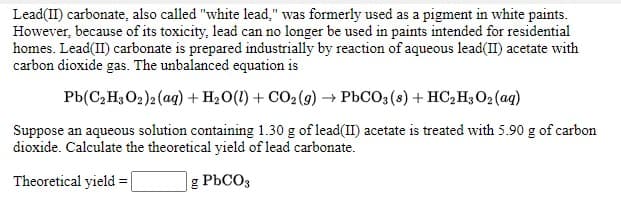Lead(II) carbonate, also called "white lead," was formerly used as a pigment in white paints. However, because of its toxicity, lead can no longer be used in paints intended for residential homes. Lead(II) carbonate is prepared industrially by reaction of aqueous lead(II) acetate with carbon dioxide gas. The unbalanced equation is Pb(C, H3 O2)2 (ag) + H2O(1) + CO2 (9) → PBCO; (s) + HC,H3 02 (aq) Suppose an aqueous solution containing 1.30 g of lead(II) acetate is treated with 5.90 g of carbon dioxide. Calculate the theoretical yield of lead carbonate. Theoretical yield = g PbCO3
Thermochemistry
Thermochemistry can be considered as a branch of thermodynamics that deals with the connections between warmth, work, and various types of energy, formed because of different synthetic and actual cycles. Thermochemistry describes the energy changes that occur as a result of reactions or chemical changes in a substance.
Exergonic Reaction
The term exergonic is derived from the Greek word in which ‘ergon’ means work and exergonic means ‘work outside’. Exergonic reactions releases work energy. Exergonic reactions are different from exothermic reactions, the one that releases only heat energy during the course of the reaction. So, exothermic reaction is one type of exergonic reaction. Exergonic reaction releases work energy in different forms like heat, light or sound. For example, a glow stick releases light making that an exergonic reaction and not an exothermic reaction since no heat is released. Even endothermic reactions at very high temperature are exergonic.

Trending now
This is a popular solution!
Step by step
Solved in 3 steps









